Orangutans and Chimpanzees share a lot of similarities, but they are quite different when you look at each of them individually. If you’re ever unsure about what the difference is between orangutans and chimps, keep this in mind:
Orangutans are an arboreal species of southern Asia and have solitary behavior. They are stronger than chimps that are terrestrial and live in Central & Western Africa. Though the population of both is decreasing rapidly, orangutans are critically endangered, while chimps are classed as endangered.
We’ll look at each of these remarkable animals in greater depth in this article, examining what distinguishes them. We’ll also look at the difficult topic that affects their loss in numbers in recent years.
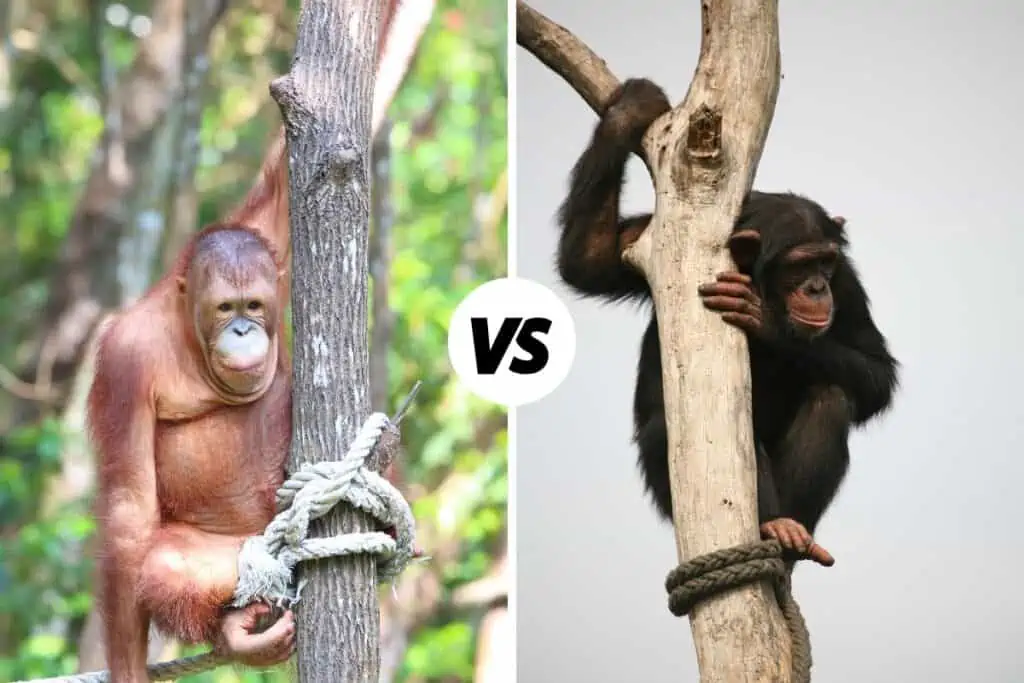
Orangutan vs Chimpanzee: An Overview
Chimpanzees and orangutans are our closest living relatives. Their genomes match ours almost percentage-wise; in fact, they are 96.4 – 98% identical to ours (chimpanzees – 98% and orangutans – 96.4%).
Not to mention, both species regularly use tools and display clear signs of high intelligence. Even with all these similarities, there are significant differences between orangutans and chimps from strength to behavior and many more that fly under the radar.
| Features | Orangutans | Chimpanzees |
|---|---|---|
| Geographical distribution | Southern Asia | Central and Western Africa |
| Habitat | Arboreal | Terrestrial |
| Diet | Frugivores – Omnivores | Omnivores |
| Height | Male: 4.1 – 5 feet Female: 3.3 feet | Male: 4 – 5.5 feet Female: 3.5 feet |
| Weight | Male: 200 – 300 lb Female: 1/3 to 1/2 of above | 70 – 150 lb |
| Lifting Force | 500 pounds | Approx. 250 pounds |
| Behavior | Solitary | Social |
| Hair Color | Brown to Reddish hair | Brown to Black |
| Lifespan | Wild: 30-40 years Captivity: 60 years | Wild: 40-45 years Captivity: 70 years |
Reproduction | Reproduce at 15.4 years of age (with a range of 13-18) | Reproduce at the age of 13 |
| Current Population | 104,700 (Bornean) 13,846 (Sumatran) 800 (Tapanuli) | 172,700 to 299,700 |
| Conservation Status | Critically Endangered | Endangered |
Geographical Distribution – Asia to Africa
Chimps and orangutans reside on different continents, and the starkest contrast is their living conditions.
Orangutans were once found throughout southeastern Asia, ranging as far north as southern China.
These red-haired apes could also be seen on Java and southern Sumatra islands.
Unfortunately, this is no longer the case. Orangutans are now only found in small pockets on Borneo’s islands of Sabah and Sarawak, with the Sumatran subspecies restricted to the northern portion of that island.
There are 9 populations of Sumatran orangutans located in Indonesian provinces Aceh and North Sumatra while Kalimantan, Sabah, and Sarawak each have their own separate ranges for Bornean orangutan populations.
Brunei does not currently have any permanent population sets for these animals.
Chimpanzees make their homes in different types of environments, from tropical rainforests to woodlands and grasslands. They’re located throughout central and western Africa, with the widest geographic range compared to any other great ape.
Inhabiting an area of over 2.6 million km² (per IUCN shapefiles), they’re found in southern Senegal as well as stretching all the way across Congo’s forested belt northward into western Tanzania and Uganda.
Habitat – Arboreal or Terrestrial
This is the starkest difference between these great apes, their habitat, and their living conditions.
Orangutans are arboreal animals, meaning they live in trees. As the world’s largest tree-dwelling mammal, they rely heavily on trees for both shelter and sustenance.
This has several benefits – it protects them from predators, and their food is always within reach.
Orangutans are easily recognizable by their long arms and gripping hands and feet, allowing them to swing from branch to branch easily.
Orangutans spend very little time on the ground; instead, they prefer using lianas (vine-like plants) to swing or jump from one tree to another.
Chimpanzees are primarily terrestrial animals who prefer to stay on the ground. They may, however, climb trees and build leaf nests there.
As a result, chimpanzees can be considered semi-terrestrial or semi-arboreal.
They sleep in ironwood trees. Chimpanzees are adaptable creatures that can survive in various environmental conditions.
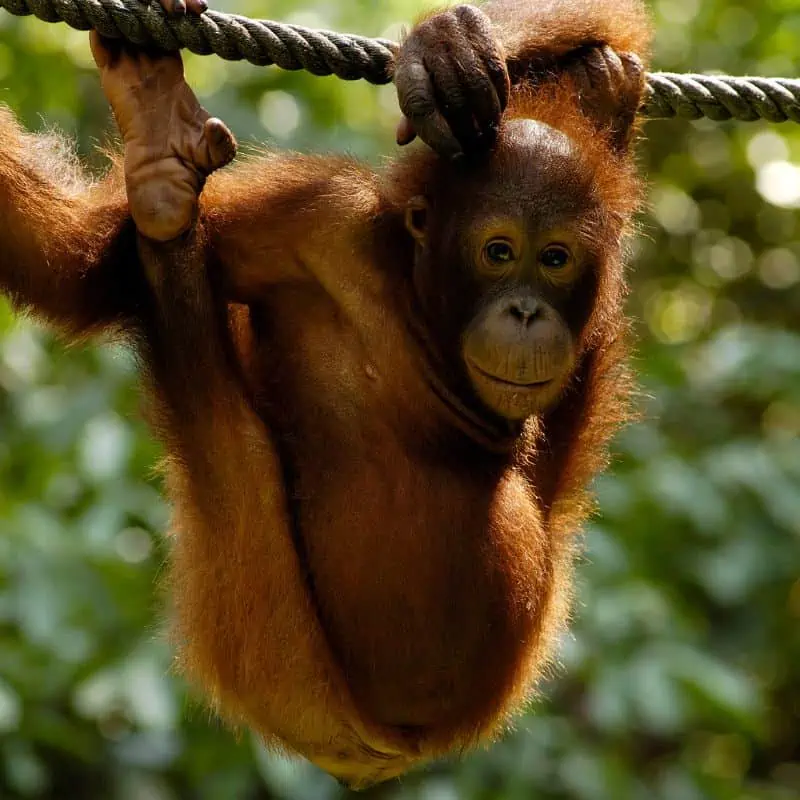
Size and Height
Orangutans and chimpanzees are apekind’s most powerful representatives, only being outdone by gorillas.
Although both orangutans and chimps are comparable in height, on average, orangutans grow larger and heavier. They differ in stature, weight, and body size, but they are both extremely robust.
The arm span of an orangutan is quite significant. A male’s arms might stretch out to a length of 7 feet from fingertip to fingertip, making them something of a reach king.
Orangutans’ hands almost come to rest on the floor when they stand upright.
- Orangutan Male – Orangutans are gentle giants, with most adults measuring between 4.1 – 5 feet tall.
- Orangutan female – On average, females stand about 3.3 feet tall, while males are about double that size.
On the other hand, Chimpanzees also have long arms and considerably stronger hind limbs.
This gives them an edge in running and leaping, and they use their arms for knuckle-walking.
- Chimpanzee Male – Chimp males have the potential to grow up to 4 – 5.5 feet tall, but most only reach a height of four feet as adults.
- Chimpanzee Female – Female chimps, on average, grow to be 3.5 feet, tall-slightly taller than their female orangutan counterparts.
Weight Differences
Although there are only minor height differences between orangutans and chimpanzees, the weights of these two species can vary by approximately 100 pounds.
Orangutans are known to be strong creatures; they have more muscle mass and can weigh up to 200 pounds. Interestingly, females usually only 1/3 to 1/2 of that.
Some of the biggest male orangutans may weigh up to 300 pounds, but most will commonly weigh considerably less than this.
Chimpanzees are also among the most powerful primates, weighing between 70 and 150 pounds in their natural environment on average, whereas females are considerably lighter.
Lifting Force
When it comes to heavy lifting, orangutans hold the superior position. Orangutans can lift weights that are twice their body weight.
Even some of the world’s strongest men would struggle to raise a comparable weight, yet orangutans can easily handle 500 pounds.
The reason for their strong lifting power is that they don’t lift just their bodies but also have to pick up their young while leaping and shifting on trees.
Orangutan infants stay connected to their mothers for the first six to eight months of life, after which they detach for brief periods before returning together again until they are around 2.5 years old.
Although chimps are known to be incredibly strong, some studies claim that they’re only 1.5 times stronger than the average human.
But this strength is often related to their size rather than anything else. For example, the average male human can lift 155 pounds, while an average chimp (1.5 times stronger) could lift around 232.5 pounds.
However, because chimpanzees are usually smaller in stature than humans, it’s unlikely that your everyday chimp would be able to achieve such a feat.
Behavior – Solitary or Social
Orangutans are less social than other apes and typically live alone, except when they mate or mothers care for their young.
Small groups of females may travel with infants to look for food, but adult males usually don’t travel in packs.
The rainforest isn’t typically known for being abundant in food, which is why orangutans are much more independent than most other primates.
However, when there are periods of great abundance, they will use this opportunity to socialize with others and gather in small groups.
Males are solitary by nature. They become hostile toward other males and females during mating season and make loud roars to keep track of one another as they travel through the woods.
Males make sounds known as “long calls,” which can be heard over a mile away.
Chimpanzees, on the other hand, are very sociable.
Male chimps lead a group of several dozen. This group is led by an alpha male and his coalition of male supporters.
Female chimps are more trusting and fearful, while males are more aggressive and violent.
Grooming is crucial in chimpanzees socializing, allowing them to bond while removing ticks and grime from one another’s bodies.
Hair and Coloration – Black to Brown
Orangutans have brown, reddish-orange hair. They are sometimes known as red apes because of their dark tan or gray skin, which is covered with rather rough and mostly sparse dark brown to reddish hair.
Meanwhile, chimpanzees’ hair is brown or black. Usually, the skin beneath the hair is white, but their face, hands, and feet are black.
The faces of younger chimps may be whitish or pinkish.
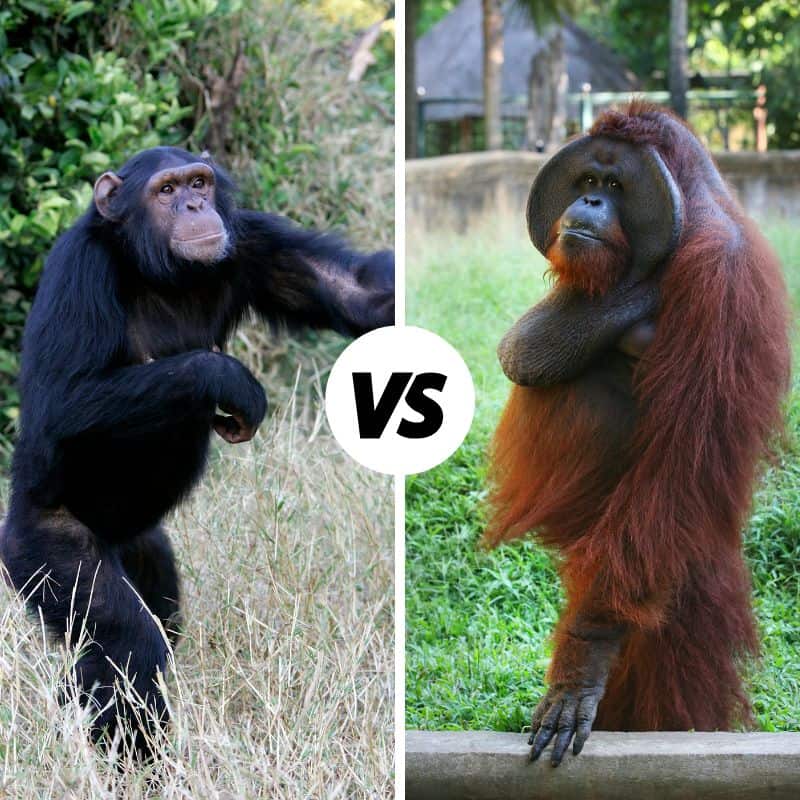
Diet – Omnivores or Frugivores
Orangutans are masters of the jungle, knowing which trees bear fruit and when. They mainly eat fruit, around 300 different kinds.
But they’re technically omnivores; on rare occasions, they’ll also consume insects, larvae, or even meat.
Chimpanzees are omnivores and are known to consume various items, including fruits, plants, and even insects.
In addition to typically eating fruit or plants, these animals have been documented to consume eggs, nuts, and hundreds of other items.
While some might consider chimps gentle creatures because they’re so closely related to humans, don’t be fooled–they’ve been known to kill small monkeys and antelope.
Tortoises aren’t safe from them either; they like to bash the hard-shelled creatures against tree trunks until the shell cracks open.
Lifespan
Orangutans have an average lifespan of 30-40 years in the wild, which may reach up to 60 years when kept in captivity.
The average lifespan of a chimp in the wild is 40-45 years. In captivity, however, chimps have been known to live for more than 70 years.
Little Mama is considered the oldest chimp in captivity, and she passed away in her late 70s in 2017.
Reproduction
Orangutans have a very long reproductive period compared to other animals.
In the wild, females reach puberty at around eight years old but are not ready to have their own babies until they’re in their teenage years.
On average, they will reproduce at 15.4 years old (with a range of 13-18), and there is typically a 9.3-year gap (Sumatran orangutan) and 7-8 years (Bornean orangutan) between each birth.
The average orangutan births one baby every nine years, although twins are extremely rare.
There is a difference in when male and female chimpanzees reach sexual maturity.
- Females start puberty at approximately seven years old but don’t achieve full maturity and begin ovulating until they become adults.
- A female chimpanzee becomes an adult by 13 years of age.
- Although male chimpanzees reach puberty at the age of 9 years, they are not considered sexually mature until they are approximately 15 years old.
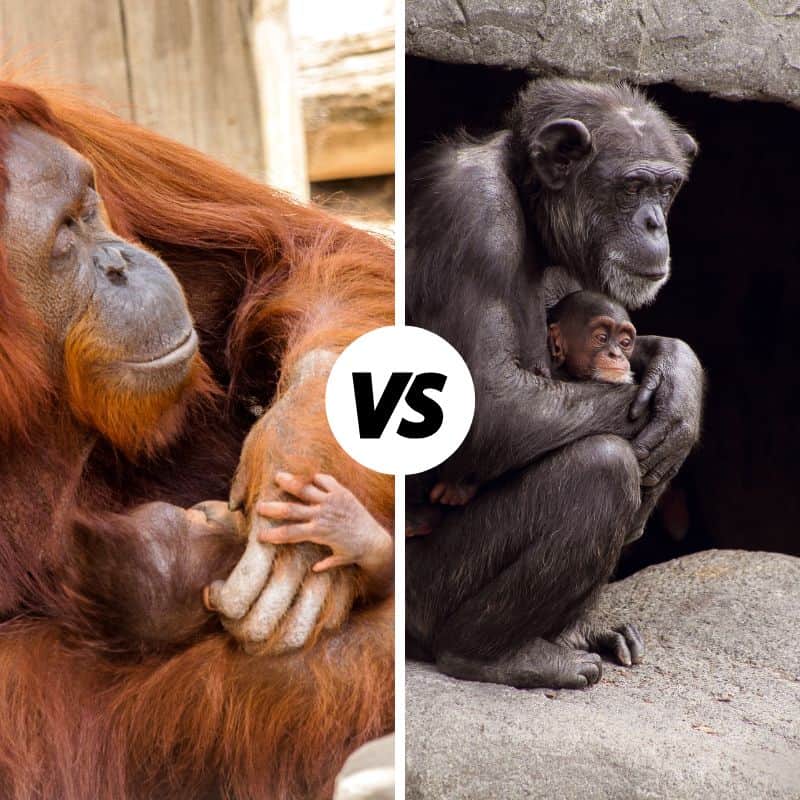
Conservation Status – Endangered or Critically Endangered
Orangutans are one of the most critically endangered great apes due to poaching and habitat loss from deforestation and palm oil plantations in Indonesia.
This is an important period for orangutans. While precise population figures are difficult to come by, some estimates are based on WWF data.
- Based on the most up-to-date geographic range, the Bornean orangutan is estimated to total approximately 104,700 individuals (Endangered).
- The Sumatran population is about 13,846 (Critically Endangered).
- The Tapanuli orangutan is the most endangered of all great apes, with less than 800 individuals remaining.
The WWF has determined that the world’s chimpanzees are also in danger, with a population of only 172,700 to 299,700 individuals remaining in the wild.
This ape species is therefore classified as endangered and placed on the red list.
Final Thoughts On Orangutan vs Chimpanzee Differences
Although orangutans and chimpanzees share most of their DNA, they have different habitats, social structures, and reproductive behaviors.
Despite rapidly decreasing populations, orangutans are critically endangered, while chimps are classed as endangered.
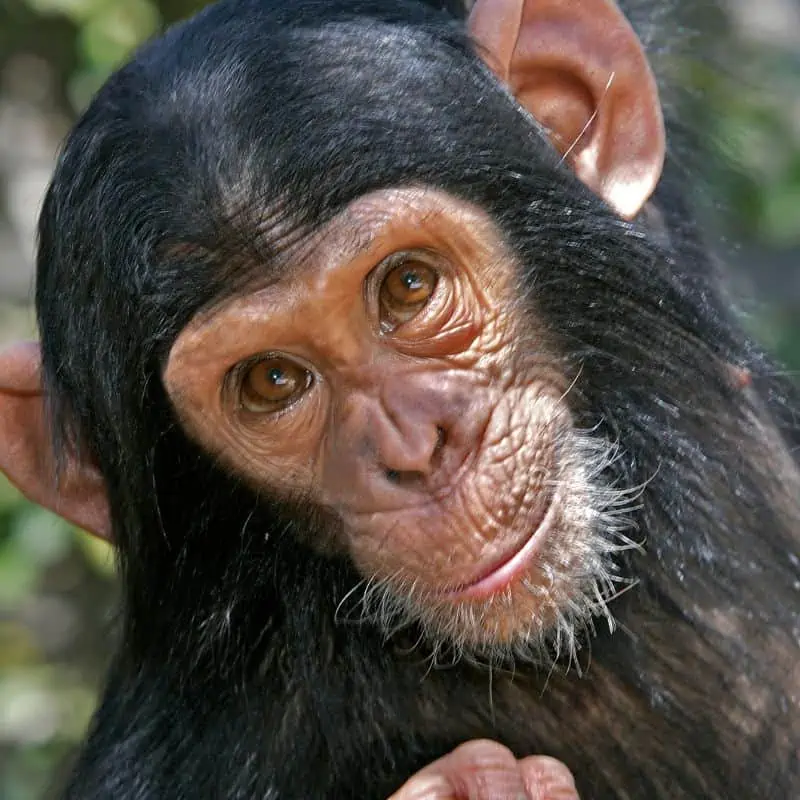
FAQs
Are Orangutans and Chimpanzees the Same?
They are not alike even though they come from the great ape family. There are many similarities between them, such as their use of tools and high intelligence. Despite all these similarities, there are significant differences between orangutans and chimps regarding strength to behavior.
Is an Orangutan Stronger Than a Chimpanzee?
Orangutans are not only the second-strongest apes but also stronger than chimpanzees. They can lift 500 pounds with little effort due to their strength. This is approximately twice their body weight. Chimpanzees can only lift about half that amount.
Are Orangutans Or Chimpanzees Smarter?
Orangutans have been recognized as the world’s most intelligent animals in a study that places them above chimps and gorillas. Orangutans were found to have an exceptional learning and problem-solving capacity among 25 primate species.
